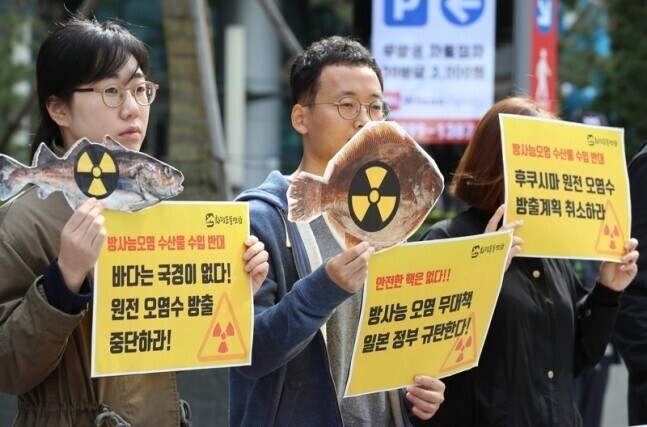hankyoreh
Links to other country sites 다른 나라 사이트 링크
How safe is Fukushima after 2011 nuclear disaster?

Ten years after the Tohoku earthquake on March 11, 2011, safety issues remain a source of controversy in Fukushima, where massive amounts of radioactive material were leaked due to an explosion at the Fukushima Daiichi Nuclear Power Plant.
Many are still worried over whether evacuated residents will be able to return or whether it is safe to eat seafood from the Fukushima region.
Within Fukushima, there are so-called “difficult-to-return zones” where access is strictly controlled due to high levels of radiation in excess of 50 millisieverts (mSv) per year. In other words, these are places that are not fit for human habitation.
They are located across six villages, accounting for roughly 2.5 percent of Fukushima Prefecture’s total area. Due to Fukushima’s large size, 2.5% is just over half the total area of Tokyo’s 23 wards. Residents of these regions would be unable to return even if they wanted to.
To allow residents to return to disaster-affected regions, the Japanese government has undertaken a massive decontamination effort to remove radioactive material. The budget alone has amounted to 4 trillion yen (US$37.9 billion).
Thanks to these decontamination efforts — along with the half-lives of the radioactive substances — the amount of radiation has indeed declined over the last 10 years. Apart from the “difficult-to-return zones,” evacuation orders have been lifted for most areas.
But some have voiced skepticism over the effectiveness of the decontamination. According to a recent report by the international environment group Greenpeace, radioactivity levels have been found to exceed the 0.23 mSv-per-hour long-term target set by the Japanese government in several of the areas where decontamination has been completed.
According to Greenpeace, this is due primarily to the effects of radiocesium.
At eight days, Iodine-131 has a relatively short half-life — the time taken for the quantity of radioactive material to decline by half — and was largely gone from the region within months after the Fukushima disaster.
According to the report by Greenpeace, analysis of samples from mountain forests showed not only cesium but also strontium-90, another carcinogen. Cesium was also detected at levels five times higher than the threshold in Korean rockfish caught in the waters off of Fukushima on Feb. 22 of this year.
Fukushima’s safety is also an important issue for other countries that import farming products and seafood. According to data from Japan’s Ministry of Agriculture, Forestry and Fisheries, 54 countries and regions had restrictions in place at one point on imports of farming products and seafood from Fukushima in the wake of the 2011 earthquake.
But the situation is different for cesium, a Group 1 carcinogen. While Cs-134 has a half-life of roughly two years, Cs-137 has a half-life of 30 years, which means that it is still present and giving off radiation in the soil and buildings.
Another possible recontamination risk in Fukushima is posed by the difficulty of carrying out decontamination in mountain forest areas. At 71%, a large proportion of Fukushima Prefecture’s total area consists of mountain forests.
While that number has significantly declined, 15 countries and regions still have restrictions in place. Nine of them, including the European Union and Indonesia, require proof of testing for radioactive substances. The other six — China, South Korea, Taiwan, Macau, Hong Kong, and the US — have outright barred imports of certain farming, fishing and food products.
At international meetings and elsewhere, Japan has availed itself of every opportunity to demand the overturning of restrictions, insisting that “some countries continue restricting imports of farming products and seafood from Fukushima without any scientific basis.”
By Kim So-youn, staff reporter
Please direct comments or questions to [english@hani.co.kr]

Editorial・opinion
![[Column] Season 2 of special prosecutor probe may be coming to Korea soon [Column] Season 2 of special prosecutor probe may be coming to Korea soon](https://flexible.img.hani.co.kr/flexible/normal/500/300/imgdb/original/2024/0426/3317141030699447.jpg) [Column] Season 2 of special prosecutor probe may be coming to Korea soon
[Column] Season 2 of special prosecutor probe may be coming to Korea soon![[Column] Park Geun-hye déjà vu in Yoon Suk-yeol [Column] Park Geun-hye déjà vu in Yoon Suk-yeol](https://flexible.img.hani.co.kr/flexible/normal/500/300/imgdb/original/2024/0424/651713945113788.jpg) [Column] Park Geun-hye déjà vu in Yoon Suk-yeol
[Column] Park Geun-hye déjà vu in Yoon Suk-yeol- [Editorial] New weight of N. Korea’s nuclear threats makes dialogue all the more urgent
- [Guest essay] The real reason Korea’s new right wants to dub Rhee a founding father
- [Column] ‘Choson’: Is it time we start referring to N. Korea in its own terms?
- [Editorial] Japan’s rewriting of history with Korea has gone too far
- [Column] The president’s questionable capacity for dialogue
- [Column] Are chaebol firms just pizza pies for families to divvy up as they please?
- [Column] Has Korea, too, crossed the Rubicon on China?
- [Correspondent’s column] In Japan’s alliance with US, echoes of its past alliances with UK
Most viewed articles
- 1AI is catching up with humans at a ‘shocking’ rate
- 2Korea’s 1.3% growth in Q1 signals ‘textbook’ return to growth, says government
- 3No good, very bad game for Korea puts it out of Olympics for first time since 1988
- 4[Column] Park Geun-hye déjà vu in Yoon Suk-yeol
- 5[Column] Season 2 of special prosecutor probe may be coming to Korea soon
- 6Division commander ordered troops to enter raging flood waters before Marine died, survivor says
- 7Is Japan about to snatch control of Line messenger from Korea’s Naver?
- 8After election rout, Yoon’s left with 3 choices for dealing with the opposition
- 9Will NewJeans end up collateral damage in internal feud at K-pop juggernaut Hybe?
- 10Marriages nosedived 40% over last 10 years in Korea, a factor in low birth rate